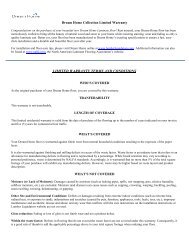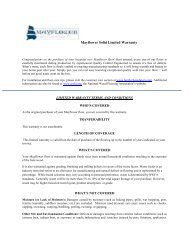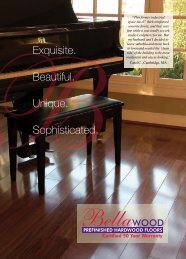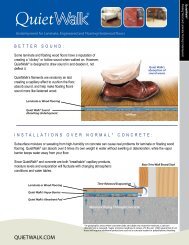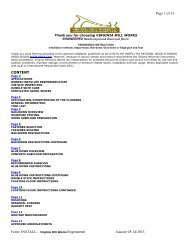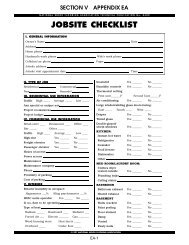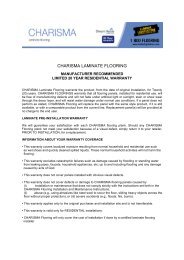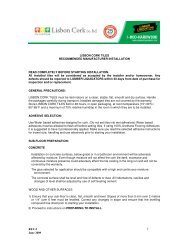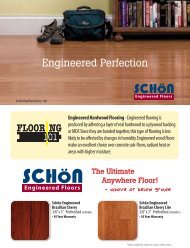OTHER SUBFLOOR REQUIREMENTS1. Ceramic tiles, terrazzo, vinyl sheet goods, linoleum and resilient (VCT) vinyl composition tile and older vinyl and linoleum tiles orsheet goods normally do not need <strong>to</strong> be removed providing <strong>the</strong>y are smooth, sound and dry. Older vinyl sheet goods and tile maycontain asbes<strong>to</strong>s. Contact your local municipalities for special precautions should you choose <strong>to</strong> remove <strong>the</strong>se older floor coverings.2. A vapor barrier is always required when installing laminate over vinyl, linoleum sheet goods, resilient tiles or ceramic tiles andconcrete.NEW CONSTRUCTIONS1. The installation should be scheduled as late in <strong>the</strong> building cycle process as possible <strong>to</strong> prevent any unnecessary damage fromoccurring as <strong>the</strong> result of o<strong>the</strong>r trades involved with <strong>the</strong> construction process. Always protect <strong>the</strong> floor if o<strong>the</strong>r trades will be walkingon <strong>the</strong> floor after installation.2. Prior <strong>to</strong> installation, <strong>the</strong> building must be closed and <strong>the</strong> climate controls should be in normal operation for at least two weeks.3. See specific product acclimation, site moisture and subfloor requirements.4. Kitchen cabinet bases should be installed before <strong>the</strong> floor is installed. However, cabinets may be installed after <strong>the</strong> floor is inplace providing <strong>the</strong> cabinets; island cabinets, etc. are not fixed /attached <strong>to</strong> <strong>the</strong> laminate floor.5. Areas of water exposure, such as <strong>the</strong> expansion space in front of <strong>the</strong> kitchen sink, in front of or around <strong>the</strong> dishwasher, around<strong>the</strong> refrigera<strong>to</strong>r space and around any water supply line, in front of any exterior doors and sliding glass doors must be sealed/filledwith a flexible 100% mildew-resistant silicone sealant.BATHROOMS<strong>Laminate</strong> flooring is water resistant, not water proof<strong>Laminate</strong> flooring may be installed in bathrooms; however, it is important <strong>to</strong> safeguard <strong>the</strong> floor from water damage.Installation in bathrooms must be made in accordance with <strong>the</strong> following <strong>instructions</strong>:1. Do not install in rooms with a floor drain.2. Avoid steam, provide ventilation and floor mats, quickly remove standing water3. All expansion spaces provided between <strong>the</strong> new flooring and walls; <strong>the</strong> doorway transition or o<strong>the</strong>r fixed objects such as pipes forradia<strong>to</strong>rs, sinks, water supply <strong>to</strong> water closet or <strong>to</strong>ilet flanges and areas of water exposure MUST be sealed with 100% mildewresistantsilicone sealant.4. When flooring is installed in a bathroom and an adjoining hall or room, a T-Molding transition must be installed in <strong>the</strong> doorwaybetween <strong>the</strong> rooms or hallway and <strong>the</strong> expansion space under <strong>the</strong> T-Molding must be filled with <strong>the</strong> proper sealant. Place sealant in<strong>the</strong> expansion space of any flooring transition in <strong>the</strong> doorway of a bathroom.KITCHENSInstallation in kitchens must be made in accordance with <strong>the</strong> following <strong>instructions</strong>:1. Kitchen cabinet bases should be installed before <strong>the</strong> floor is installed.2. Areas of water exposure, such as <strong>the</strong> expansion space in front of <strong>the</strong> kitchen sink, in front of or around <strong>the</strong> dishwasher, around<strong>the</strong> refrigera<strong>to</strong>r space and around any water supply line, in front of any exterior doors and sliding glass doors MUST be sealed with100% mildew-resistant silicone sealant..3. Install <strong>the</strong> planks up <strong>to</strong> <strong>the</strong> cabinet kick plate, leaving <strong>the</strong> expansion space. Cover <strong>the</strong> expansion space with a quarter roundmolding.LAUNDRY ROOMS<strong>Laminate</strong> flooring may be installed in laundry rooms; however, it is important <strong>to</strong> safeguard <strong>the</strong> floor from water damage.1. All expansion spaces in a laundry room MUST be filled with sealant.2. <strong>Laminate</strong>s must not be installed in rooms with a floor drain or sump pump.3. Areas of water exposure, such as <strong>the</strong> expansion space near a sink, around any water supply line, MUST be sealed with 100%mildew-resistant silicone sealant.4. When flooring is installed in a laundry room and an adjoining hall or room, a T-Molding transition must be installed in <strong>the</strong>doorway between <strong>the</strong> rooms or hallway and <strong>the</strong> expansion space under <strong>the</strong> T-Molding must be filled with <strong>the</strong> proper sealant. Placesealant in <strong>the</strong> expansion space of any flooring transition in <strong>the</strong> doorway of a laundry room.RADIANT FLOOR HEATING<strong>DREAM</strong> <strong>HOME</strong> flooring can be used in combination with many types of in-floor heating.1. Follow <strong>the</strong> <strong>instructions</strong> from <strong>the</strong> supplier of <strong>the</strong> floor heating system.2. Concrete subfloors must be installed and cured a minimum of 60 days.3. The heating system must be in operation for at least two weeks before installation <strong>to</strong> dissipate any residual moisture. Duringinstallation, <strong>the</strong> system may be turned off or set <strong>to</strong> a suitable installation temperature 65 <strong>to</strong> 75°F.4. Adjust <strong>the</strong> heating system gradually. The heating surface temperature must not exceed 85°F.INSTALLATION WITHOUT CLIMATE CONTROLFor best results, follow <strong>the</strong> ACCLIMATION guidelines found on page 1.1. Installation installations must be met.2. The crawl spaces must be enclosed and vented and meet all requirements, and <strong>the</strong> job site conditions must be correct.3. Insulation of <strong>the</strong> floor in <strong>the</strong> crawl space is recommended.4. The floor must not be installed in an area where it will be exposed <strong>to</strong> constant dampness or extremely high or low humidity.5. Relative humidity must range between 35-75%. The temperature should be at least 60-85°F for <strong>the</strong> product acclimation and atleast two days after <strong>the</strong> installation.6. Summer homes that are closed without adequate ventilation during hot and humid seasons will exhibit closed or “green housesyndrome” where <strong>the</strong> interior humidity level rises above 90%. Ventilation of <strong>the</strong>se homes is highly recommended.SEASONAL CHANGES - What <strong>to</strong> expectTo assure that your floors provide lasting satisfaction note <strong>the</strong>se recommendations below:Seasonal gapping should be expected in all wood products and does not constitute a product failure.It is normal that wood products will be affected by environmental fluctuations in humidity and temperatures within a building. Therelative humidity should be 35-75%, with temperature of 60-85°F. Correct acclimation will minimize plank gapping or swelling.3
• (Dry) Heating Season - A humidifier may be needed <strong>to</strong> improve low humidity levels. Wood s<strong>to</strong>ves, radiant floor heat and electricheat all create dryer conditions.• (Humid, Wet) Non-Heating Season - Proper humidity levels can be maintained by use of an air conditioner or dehumidifier. Avoidexcessive exposure <strong>to</strong> water during periods of inclement wea<strong>the</strong>r. Do not obstruct expansion joints around <strong>the</strong> perimeter of your floor.COMMERCIAL APPLICATIONS -products designated commercial1.Areas greater than 27’ feet in any direction such as; (one room, two or more adjoining rooms, archways greater than 4’ feet andlarge rooms with a connected hallway) must have T-molding breaks installed across <strong>the</strong> room, at <strong>the</strong> archway or at <strong>the</strong> beginning of<strong>the</strong> hallway or entry <strong>to</strong> provide additional expansion space.2. Areas greater than 27’ feet in any direction will also require a <strong>to</strong>tal of 1⁄2" expansion space around <strong>the</strong> perimeter of <strong>the</strong> room andall fixed objects, walls, pillars, pipes.3. When fastening fixtures <strong>to</strong> a floating floor, <strong>the</strong> anchoring bolts or fasteners must have <strong>the</strong> same expansion space 1⁄2” around eachbolt or fastener as required for walls, pillars, pipes and o<strong>the</strong>r fixed objects.4. Transitions and moldings that accommodate <strong>the</strong> 1⁄2" expansion space is strongly recommended.4PLANNING1. <strong>DREAM</strong> <strong>HOME</strong> <strong>Laminate</strong> Flooring is intended for indoor use only, is designed as a glueless floating floor and should not be glued ornailed <strong>to</strong> <strong>the</strong> subfloor. Inspect all planks for visible defects and damage before and during installation. Do not install damaged planks.During installation, inspect <strong>the</strong> groove area for any debris that may prevent proper assembly of planks.<strong>DREAM</strong><strong>HOME</strong> <strong>Laminate</strong> Flooring will not accept responsibility for claims on flooring installed with obvious defects.2. Determine in which direction <strong>the</strong> planks will be installed. To make <strong>the</strong> room appear larger or if installing in very small rooms orhallways, it is preferable <strong>to</strong> lay <strong>the</strong> planks parallel <strong>to</strong> <strong>the</strong> longest room dimension.3. End-joint “shadow” can be minimized, avoid running board direction in<strong>to</strong> <strong>the</strong> primary light source.4. Carefully measure <strong>the</strong> room <strong>to</strong> determine squareness and <strong>the</strong> width of <strong>the</strong> first and last row of planks. If <strong>the</strong> width of <strong>the</strong> lastrow of planks is less than 2” excluding <strong>the</strong> <strong>to</strong>ngue, adjust <strong>the</strong> width of first plank row accordingly.3. 4.WHEN INSTALLING PLANKS5. The <strong>to</strong>ngue side of <strong>the</strong> plank should face <strong>the</strong> starting wall. To get <strong>the</strong> laminate row closer <strong>to</strong> <strong>the</strong> wall you may remove <strong>the</strong> <strong>to</strong>nguefrom <strong>the</strong> starting row of planks only. Begin laying planks on <strong>the</strong> left side corner of <strong>the</strong> starting wall and work <strong>to</strong> <strong>the</strong> right side. Whencutting planks, make sure <strong>the</strong> teeth of <strong>the</strong> power saw blade is cutting in<strong>to</strong> <strong>the</strong> decorative surface. Best results are achieved whenusing a thin, carbide tipped cutting blade.6. Example of incorrect board placement5. 6.



